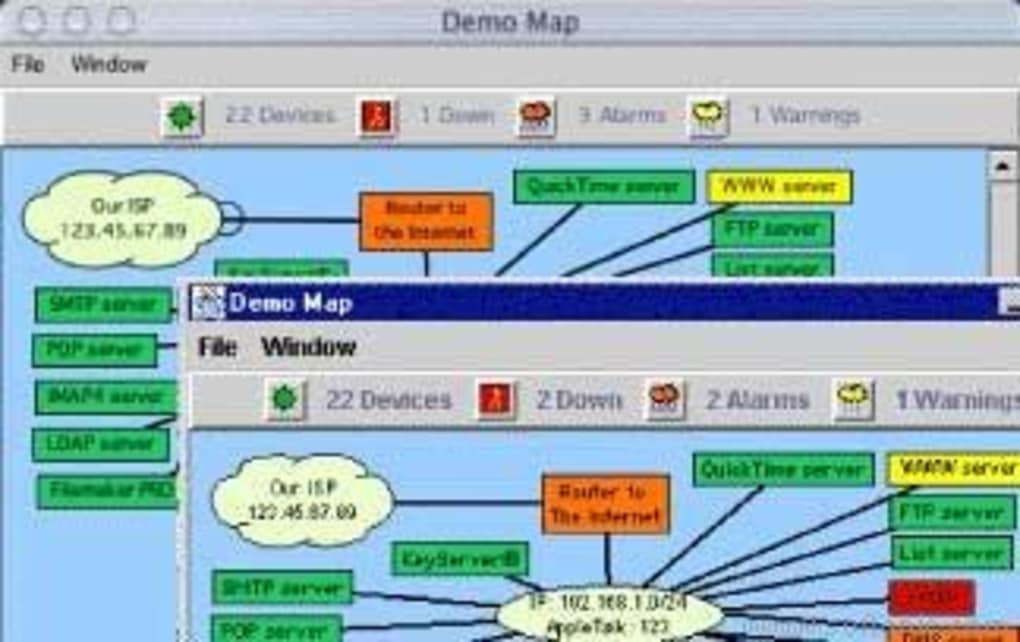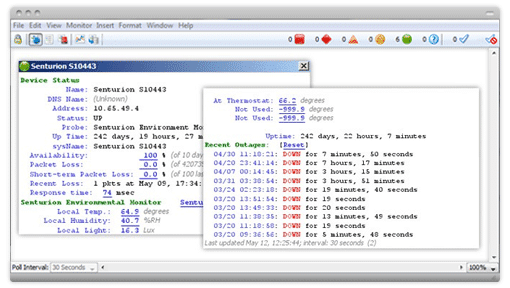
The normal state of the device is UP/OKAY. It does this by retrieving information from the InterMapper Flows server. The Flow Exporter Status probe monitors a Flow Exporter and reports statistics about the Flow activity. This probe will create an empty collection device. It was renamed to reflect its purpose more accurately. Note: This "SNMP Traffic" is exactly the same as the "SNMP MIB-II" probe of earlier versions. This also displays sysLocation, sysContact, and sysUptime from the system group in the device's Status Window.

It displays traffic (bytes/second, packets/second, errors/minute) for each of the interfaces by right-clicking on a link to open the Status Window. This information comes from the system and interfaces groups of SNMP MIB-II. The SNMP Traffic probe retrieves system and traffic information from a device. Thus it can take up to nine seconds to declare a device to be down. The default setting for the number of echo requests is three, and the default timeout is three seconds. If InterMapper reaches that limit without receiving a response, InterMapper declares the device to be down. Each device has a limit of the number of pings to send (determined by the device's limit or the map's limit). If no response is received after that time, InterMapper re-sends the echo request, waiting again the device's Timeout. The time it waits is determined by the device's Timeout. InterMapper sends the ping packet, then waits for a response. To send the same IP packet size to an IPv6 target, set the number of data bytes to 1452. Tip: To send a 1500 byte IP packet to an IPv4 target, set the number of data bytes to 1472. Data Pattern specifies the hexadecimal pattern that is repeated throughout the payload contents. The mimimum value permitted is 16 bytes the maximum is 2000 bytes. Number of Data Bytes specifies the number of bytes of ICMP data to send. The Ping/Echo probe sends an ICMP echo request packet to the target device to determine if it is active and responding.
#Not connected to an intermapper server on osx password#
Password is the password for the corresponding username.

Username specifies a user name that has read-permission on the map. Map Name specifies the name of the map on the remote server. Then select Map Status for the probe type, and configure it with: To make a device with the "Map Status" probe, create a device with the DNS Name or IP address of the InterMapper server being monitored (or "localhost" if it's a local map) when adding the device to the map. Double-clicking the icon with InterMapper Remote opens a window with the remote map and brings it to the front. InterMapper periodically queries the specified map, and the icon displays the status of the "worst" item on that sub-map. This probe allows InterMapper to monitor the state of a map running on another InterMapper server. If a proper SNMP response is received, InterMapper sets the device's probe to be SNMP otherwise, InterMapper sets the device to use a Ping/Echo probe. InterMapper sends a SNMP GetNextRequest for the sysName, sysObjectID, and sysServices OIDs (1.3.6.1.2.1.1.5.5, 1.3.6.1.2.1.1.5.2, and 1.3.6.1.2.1.1.5.7, respectively) using the specified SNMP Read-only community string. The Automatic probe attempts to determine whether the device speaks SNMP or whether simply to ping the device. Base Folder: /Users/richb/Documents/src/Probe- >HTML/BuiltinProbes/


 0 kommentar(er)
0 kommentar(er)
